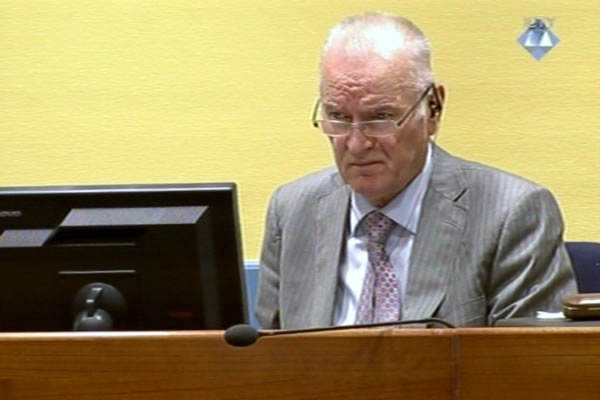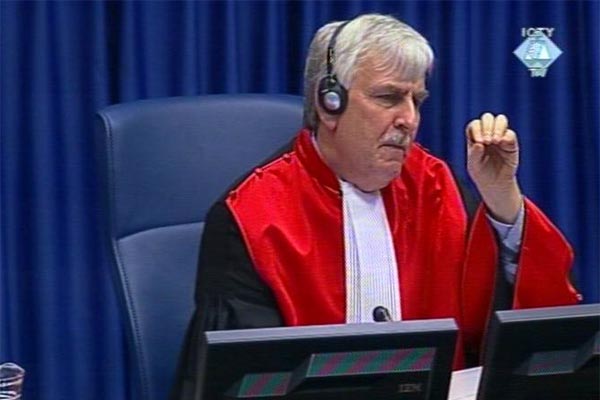Home
PRISONERS IN NOVA KASABA: WAS A LIST MADE OR NOT?
Former military police commander in the 65th Motorized Protection Regiment of the VRS Main Staff couldn’t explain in his evidence at the trial of Ratko Mladic why a list was made of the names of all the Muslims detained in the football stadium in Nova Kasaba on 13 July 1995. The list was never completed and the lists of detainees were never used
 Ratko Mladic in the courtroom
Ratko Mladic in the courtroom In the final part of his evidence at the trial of Ratko Mladic, protected witness RM 253 said again that the former VRS Main Staff commander told the Muslims detained in the football stadium in Nova Kasaba on 13 July 1995 that they would be put on trucks and exchanged. Instead of the exchange, the detainees ended up at execution sites near Zvornik, such as the Petkovci Dam. The indictment alleges that about 1,000 men were executed at the Petkovci Dam. The only survivors were Witness RM 253 and another detainee.
After Witness RM 253 completed his evidence, the prosecution called Zoran Malinic. On 13 July 1995, Malinic, former military police commander in the 65th Protection Regiment, was in charge of securing about 1,200 Muslims captured after the fall of Srebrenica, while they were detained in the football stadium in Nova Kasaba on 13 July 1995. The transcript of Malinic’s testimony at the trial of Zdravko Tolimir in June 2011 was admitted into evidence. The prosecutor read out the summary of Malinic’s evidence. Malinic testified under his full name but with image distortion as a protective measure. The Trial Chamber warned Malinic that he was not obliged to give any answers that might incriminate him.
As he answered the prosecutor’s questions, Malinic said that on13 July 1995 about 1,200 captives from the column of civilians and soldiers who were trying to break through to Tuzla after the fall of Srebrenica were brought to the football stadium in Nova Kasaba. As soon as the detainees were brought to the football stadium, the guards started drawing up lists with their names; the effort was put on hold for a while when General Mladic addressed the detainees, Malinic claimed. Mladic promised the detainees that they would be exchanged.
The effort to draw up the list continued until the detainees were taken from the football stadium; the lists remained incomplete, because, as Malinic explained, there was no time to put everyone’s name on the list. Also, Malinic confirmed that the lists were not handed over to the soldiers who escorted the convoy with prisoners from Nova Kasaba. As Malinic noted, he kept the lists and nobody asked to see them. The prosecutor asked Malinic whether he found it strange because these men were to be exchanged, as Mladic had promised. Malinic said he did not find it strange at all, because he knew ‘those man had to undergo security checks’; the checks were to identify those who were wanted for war crimes.
Presiding judge Orie was also prompted to ask, ‘what was the purpose of the lists?’. It was done because the rules of service required it, Malinic explained. You had to ‘get the personal details from the persons you captured in order to know their identity’, Malinic noted. Recalling that the lists were never completed, the presiding judge remarked that obviously it was a rule one could either comply with or not.
As the hearing drew to a close, Mladic’s defense began cross-examining the witness.
Photos
Linked Reports
- Case : Mladic
- 2013-06-11 EXECUTION SITE AT PETKOVCI DAM
- 2013-06-10 EAR-WITNESS OF THE EXECUTION IN KRAVICA
- 2013-06-07 VICTIMS OF FIGHTING AND REVENGE
- 2013-06-14 SECURITY BEFORE EXECUTION
- 2013-06-18 WHEN DID MLADIC RETURN TO CRNA RIJEKA?
- 2013-06-20 COULD MLADIC REALLY NOT KNOW WHAT ‘EVERYONE ELSE KNEW’

